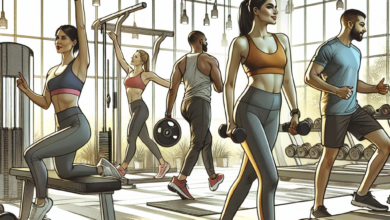Olympic Lifting Program Basics: Structure, Intensity, Volume, & Lifts

Once you’ve decided to begin an Olympic weight lifting program, you’ll find there’s a unique and structured level of commitment needed that isn’t required of every fitness program. Whether looking to start an Olympic lifting program purely for the fitness benefits or seeking to participate in a weight lifting event eventually, it’s crucial that the proper steps are taken. After all, the lift moves that comprise a suitable Olympic lifting program are well-known in the fitness world to be challenging to master.
In this article, we’ll explore the basics required to get started with an Olympic lifting program. Starting on the right foot with your new program will give you the best chance of success.
Lifts
A traditional Olympic lifting program is comprised of six different lifts that you’ll need to master. Below, we’ll review the basics of each one:
Snatch
- Stand with feet spread apart at hip-width. Bend over and place your hands at shoulder distance onto the weight bar on the ground while keeping your palms facing towards you.
- Placing all pressure on your legs and hips, lift the weight bar while still in the squatted position.
- Stand straight and lock your knees while maintaining the bar at the same level.
Push Press
- Hold your weight bar up at the clavicle level with palms facing upwards.
- Begin to bend your knees as you take a breath in and then raise the bar above your head as you breathe out and lock your elbows in a straight position.
- Straighten your legs and lock your knees while maintaining the weight bar in the same position.
Clean and Press
- While keeping feet at hip-width and holding the weight bar down with elbows locked, bend knees halfway.
- Keeping knees bent in the same position, lift the bar to shoulder height.
- Lift the weight bar above your head and lock elbows in place.
- While keeping the weight bar in the same position, straighten your legs and stand up.
Hang Clean
- This move begins with knees slightly bent and placed at hip-width. The bar is held with palms facing downwards.
- While squatting knees further, lift the weight bar to shoulder height with palms facing upward.
- Stand up straight and lock knees while continuing to hold the weight bar at shoulder level.
Hex Bar Deadlift
- Using a hex bar, begin by standing inside of it with feet placed about hip-width.
- Get into a squat position by bending your knees, then follow placing your hands on the outside of the hex bar.
- Extend knees to stand up while lifting the bar into a downward position and keeping arms straight.
Power Clean
- Begin this move in a full squat with knees bent. Hands should grip the weight bar with palms facing downward.
- While keeping the spine straight, jut upwards while pushing the weight bar to just below shoulder height.
- Move back to squat position while hoisting bar to shoulder level and placing palms facing up.
- Straighten into standing position and lock knees while keeping bar at shoulder height.

Volume and Intensity
The volume and intensity used in an Olympic weight lifting program will vary from person to person, depending on individual needs and experience. In the beginning, the most important thing is to master the techniques needed for each of the lift moves above. That being said, placing less focus on the amount of weight being lifted and instead focusing on repetition can prove helpful. Consider beginning your program with less weight and conducting about 15 repetitions each. Then, over time, you can increase the weights used as you perfect the lift moves.
Structure
Just as with any weight lifting routine, you don’t want to overdo it because this can lead to muscle damage or other physical injuries. At the beginning of your new Olympic weight lifting routine, going through the various lifts for about an hour across three days each week should suffice. As you gain more experience and feel comfortable with the lifts, you can eventually look to extend your session lengths to just over an hour five times each week.

Pro Tips
Beginning your Olympic weight lifting journey is absolutely worth it but certainly comes with its challenges. To help place you on the track for success, we’ve compiled some pro tips to maximize your Olympic weight lifting routine:
- Rest – As hard as you work on perfecting your Olympic lifts and strength training, it’s equally vital that you allow your body and muscles to rest adequately. For instance, if you are on a three-day schedule, consider spreading the days out so you can relax every other day.
- Stay Consistent – Consistency is absolutely crucial in any form of weight training. Once you’ve set your schedule, try to stay on track with it as much as possible to give yourself the best chance at learning and improving on the techniques.
- Eat Well – Nutrition is so important during weight training. When planning your Olympic lifting program, be sure to include plenty of lean proteins and healthy fats and calories that can help with muscle building. Some lifters have also found success by incorporating intermittent fasting into their nutritional schedules.
- Incorporate Core Strength Building – While your primary focus may be on your Olympic lifting program, it’s important that you continue to strengthen your core through exercises designed to build your support in the areas needed to so that you can continue to improve. By focusing on developing a well-balanced fitness and strength routine, you can see a vast improvement with your Olympic lifting program.
- Begin With the Hardest Set – When you start fresh each day, beginning your set with the lift you’re struggling the most with can help. By tackling your toughest lift first, it allows you to go all-in with the most energy and coordination, thus giving you the best chance of success and continued improvement. Once you’ve completed your first set, continue to work your way down the line according to the level of experienced difficulty.



